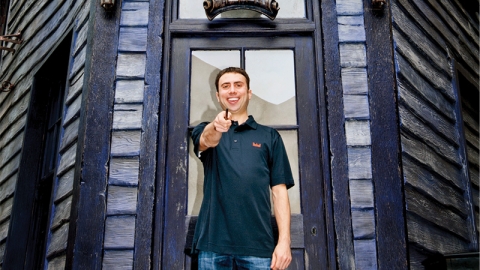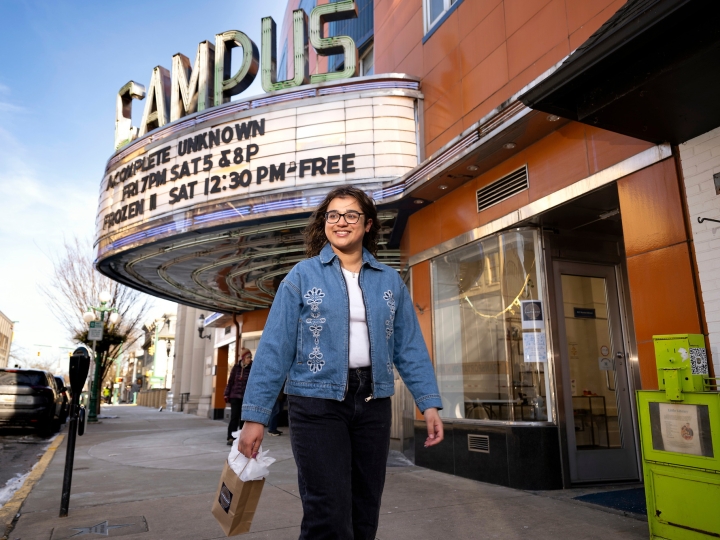
The Wonderful World of Wizardry
June 25, 2015
Justin Schwartz ’04, one of the engineers behind The Wizarding World of Harry Potter at Universal Orlando Resort, says the magic is in the details. Photography by Robert Landry
Once during his college days, while happily ensconced in his room reading, Justin Schwartz ’04 was so caught up in a book that he lost all sense of time and completely missed his geography class. He was mortified. “That just wasn’t like me at all,” says Schwartz. “I never missed a class without a good reason.”
The book to blame was Harry Potter and the Prisoner of Azkaban by J.K. Rowling. His obsession with Harry Potter may have caused him some chagrin that day in 2002, but it served him well a few years later when he was working as a ride engineer in Orlando, Fla. Schwartz had been hired by Universal Orlando Resort, which had just received the contract from Warner Brothers to create The Wizarding World of Harry Potter, and that early fascination put him at the top of his class — with the best young wizards from Gryffindor, Hufflepuff, Ravenclaw and Slytherin — as he was the only team member who had read the Harry Potter series. (These days, knowledge of the books and movies is a must for any Universal employee working on a Potter-related ride or concession.)
Schwartz is in an elite group — there are fewer than 100 ride/show engineers in the world who do the kind of work that he does — and his creativity does not disappoint. When he first arrived on the Universal stage in 2006, he was assigned to help develop the Hollywood Rip Ride Rockit, a roller coaster that delivers a multimedia experience while approaching the legal speed limit in most states at 65 m.p.h. Each car holds six people, and each bucket seat is equipped with speakers that only the rider can hear. Before the ride begins, passengers choose from a selection of 30 different songs — ranging from Limp Bizkit’s “Rollin’” to Kanye West’s “Stronger” — to provide the music for their ride. In addition, each guest is filmed during the ride, and by the time riders disembark the Rockit, a video with the their chosen song as a soundtrack is available for editing and downloading.
Despite the technological changes of the last six years, the coaster still is relevant. It still rocks it.
According to Schwartz, “The ride’s non-inverted loop is the first of its kind and employs maneuvers that are unique to this day. The Music Plaza, lighting and audio all incorporate a different piece of media,” he says. “You get your very own music video.”
Schwartz has been at Universal for nearly 11 years, and by his own admission, he most likely will be there until the end of his working days. It’s a seemingly rare move these days by a Millennial — depending on which study you read about his age cohort, Millennials are staying in their jobs two to five years, experiencing as many as 15 to 20 career changes.
With his 1950s sense of company loyalty and his 21st-century vision of technological possibility, Schwartz is, at the very least, an interesting anachronism. He’s a man who’s trusting enough to follow his childhood dream of making roller coasters and other amazing things, but also savvy enough to understand that to remain at the top of his professional world, he must always be pushing the boundaries of knowledge, imagination and engineering.
Case in point: Bringing the two unique areas of The Wizarding World of Harry Potter and the Hogwarts Express to life in the non-magical, three-dimensional world we Muggles inhabit is nothing short of magic itself.
Universal’s newest theme-park area, The Wizarding World of Harry Potter—Diagon Alley, opened last summer, and is Schwartz’ latest project. It must be more real than the movie set, which is based on a brilliant invention that does not have to obey the laws of physics, motion, gravity or time. If you think about it too long, you could very well end up having a philosophical debate with yourself on exactly what reality means here. Call it the “Potter Paradox.”
But there is no artifice in recreating this artifice. The process requires the mastery of engineering; a thorough understanding of and adherence to safety codes; knowledge of set, light and sound design; a sense of razzle-dazzle; and an obsessive attention to detail.
The dragon atop Gringotts Bank spews real fire that can be felt 40 feet below, and the goblin tellers are freakily realistic. Then, there are the interactive magic wands. With a certain flick of the wrist at certain places in Diagon Alley and in the original Wizarding World of Harry Potter—Hogsmeade in Universal’s Islands of Adventure, the owner of a wand can make things happen — a fountain flows, puppets dance, a lantern lights.
“We knew from the start that we wanted to make the wands interactive,” says Schwartz. “Our creative team wanted to make it feel like a real wand. It was always a part of our plan to make the magic real, but the technology wasn’t there in 2011. When our creative teams come up with a concept, we don’t say no but figure out how to say yes. Originally, the wands were my responsibility, but I had to pass the project off to focus on other things.”
One of those other things was designing, building and launching the Hogwarts Express, for which Schwartz was the lead engineer.
To arrive at the train’s boarding platform, you pass through a brick wall just as Harry, Ron and Hermione did in King’s Cross Station. Of course it’s an optical illusion, but it’s remarkable nonetheless. Standing on Platform 9¾, complete with a stack of travel trunks and Hedwig the owl in a cage, Schwartz explains the challenges of bringing the beloved and iconic train into being. “Not only did we have to be true to J.K. Rowling’s vision and the movies, but we also had to take things into consideration that the movies did not,” he says, “How to get our guests — some of them children in strollers or people in wheelchairs — on and off the train, and how to do it safely.”
Schwartz says that the engineering team considered no detail too trivial. Part of the design process involved riding the actual steam train the Hogwarts Express was based on and replicating its measurements down to the exact millimeter. “I can’t even tell you how many hours we spent discussing what kind of bolts to use,” says Schwartz.
From the timbre of the train’s whistle to the fluffy smoke from its stack to the rusted rails to the intricate bricked walls of King’s Cross Station, everything about the train feels authentic. Years of paying attention to detail went into making the fantastical tangible. Even the travel posters that line the train station corridors, Schwartz points out with pride, are not of London but of Orlando.
Schwartz has ridden the Hogwarts Express, which connects Universal’s two theme parks, hundreds, maybe thousands of times. He’s used to the journey. But when riding the train with first-timers, his eyes gleam. True to Harry Potter’s experience, each car holds eight people. The fabric for the seats, purchased in the U.K., is the same fabric used in the movies. The wood is a fine mahogany. And the ride moves just as you would expect a steam train to move. The windows are computerized screens, but you barely notice that as you watch the Gaelic-green countryside slide by, the spires of Hogwarts castle shimmer in the distance and Hagrid putters along on his magical motorcycle. Through the frosted glass car door, you see and hear the deadly Dementors in the aisleway, their very touch against the glass chilling. When you ride the train back from Hogsmeade, Hagrid waves goodbye at the station, and you see the Knight Bus weaving through the London streets as you return to the city. Here, anything seems possible.
Schwartz’ mentor and friend, Engineering Professor Steve Shooter, says, “You can’t help but get excited and interested about what Justin is doing when you talk to him. He has an incredible energy. What I have learned most from Justin is how to be tireless in pursuit of your dream job. He created that opportunity at Universal for himself. He was willing to do whatever it took to get it. And he continues to impress people every day.”
“I’m always working on big projects. Whenever we take on a new task, it’s definitely special,” says Schwartz. “Everything we do is groundbreaking. Whenever Universal makes an announcement, make sure you listen.”
And people are impressed. Recently, the Themed Entertainment Association, the premier professional organization for Schwartz and his cohorts, created a brand-new award specifically to celebrate The Wizarding World of Harry Potter—Diagon Alley. In late March, Schwartz was among a handful of Universal luminaries to receive the Paragon Award that “recognizes the entire land, integrated retail and food and beverage, and the Hogwarts Express, in addition to the wand technology.”
The magic lies in all the details that make the surreal seem so real. Yet there is one more detail that Schwartz will not mention, though his wife, Rachel Laskow Schwartz '03, will. It’s a small plaque riveted to the train car wall, and it bears the names of the engineers who designed the Hogwarts Express. “Schwartz” is one of them. This is the only deviation from the movie set, and yet, it also is magical.
Gigi Marino is the former editor of Bucknell Magazine. She currently is director of communications at the University of Florida’s College of Liberal Arts and Sciences.

